Microscopic test for malaria

Microscopic diagnosis of malaria is done by a trained laboratory technician at health centre or hospital level. It is not your responsibility to do a microscope test, but this section will briefly explain it so you understand the technique.
Microscopic diagnosis involves taking a small amount of blood from the patient, staining it and looking at it under a microscope to check for malaria parasites. In most cases of malaria, microscopic examination of thick and thin films of finger-prick blood will reveal malaria parasites. Thick films are 20–40 times more sensitive than thin films for detecting Plasmodium parasites, and are particularly useful if the number of parasites is low. Thin smears are also useful as they can allow identification of particular Plasmodium species (Figure 7.11). The diagnostic accuracy relies on the quality of the blood smear and the experience of laboratory personnel.